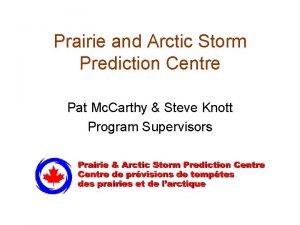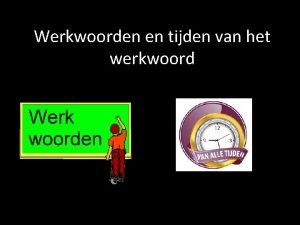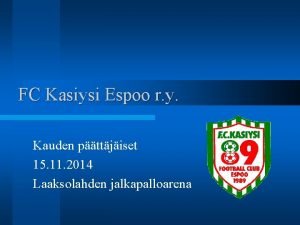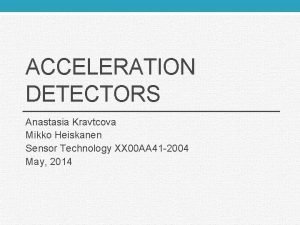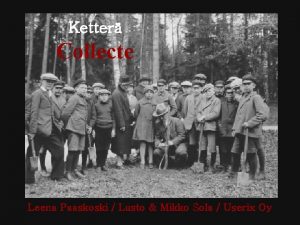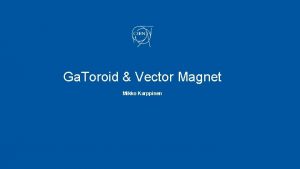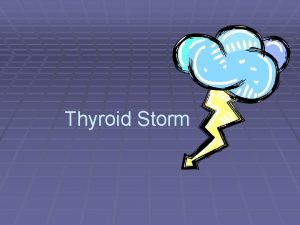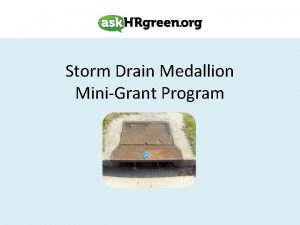Storm detection tracking and prediction Mikko Hiirsalmi VTT













- Slides: 13

Storm detection, tracking and prediction Mikko Hiirsalmi VTT MMEA 5 th year autumn result seminar Syke, Mechelininkatu 34 a (Muuttohaukka h 118) Wed, 8. 10. 2014 9: 30 -12: 30

Motivation § To be able to warn citizens on approaching storm fronts. § Driver travel planning assistance § Alerts for a desired location. § Etc. § What is needed to build such warning systems? § Storm detection § tracking § trajectory nowcasting 08/10/2014 2

How? § Storms are detected from rain intensity radar images supplied by FMI. § Typically new images arrive every 5 minutes. § Accessible via the open data interface (see FMI open data: https: //en. ilmatieteenlaitos. fi/opendata ). § Analysis is based on § basic radar image analysis and § detecting temporal storm tracks of detected storm areas and § forecasting of the future trajectories. § Storm detection and tracking is based on FMI’s legacy Matlab program which has been tailored to also produce future trajectory forecasts. § In MMEA, § the Matlab program is run as an Octave program and § the analysis chain is embedded as a MMEA Computation. Service polling newest radar images from FMI and performing the analysis tasks with Octave and § feeding the results forward via ESB bus as MMEA messages to future warning systems. § The integration is done by Okko Kauhanen from UEF and § an example of a storm aware driver routing assistance system is being drafted by Markus Stocker from UEF. 08/10/2014 3

Detection of storm polygons 08/10/2014 4

On the detection process § Basic image analysis techniques include § suitable thresholding on the radar images to eliminate noise and low rain intensities. § Image is binarized and morphological closure operation is used to remove small holes in the image and § storm cell detection is done by contour function in Matlab. § After this storm cells are represented as polygonal areas. § Then temporal clustering is used to group storm cell polygons to larger clusters and to associate clusters from successive temporal images together. § Storm tracks are formed by detecting the found dependencies and represented as tree structures of cluster histories. § Previously separate storm cells may § merge together at later times, § may disappear or § may split to multiple separate cells. § Also new storm cells may emerge. 08/10/2014 5

Storm tracking visualization • History of storm tracks • Cluster centroids visualized over time • Splits • Merges • Steady movement • Storm cell • mergers marked with green • splits with magenta • Default colour is red • Difficult to tell the temporal order of tracks in this figure. 08/10/2014 6

On the forecasting process § The future paths of the centroids of the detected storm cells are being forecast by fitting a prediction model on the detected track observations and forecasting future positions for the tracks with the estimated model. § Weighted linear regression is being used. § one gives a larger weight to the newer observations and therefore adopts faster to changes in the storm direction or speed. 08/10/2014 7

Example of forecasts 08/10/2014 8

Uncertainty of the forecasts § Accuracy needed for reliable warnings, but still open. § Storms are rapidly changing. § Detecting areas with heavy rain and grouping these into larger areas. § May result into rather large areas at times. § Also many small areas. § Temporal tracking occasionally causes noise in predictions § As small areas may be submerged into bigger areas causing large velocities on cluster centroids at those times. § Only forecasting the progression of the cluster centroids. § The area and shape are supposed to stay similar to the last observed cluster. 08/10/2014 9

Storm prediction awareness with Wavellite/Sense 08/10/2014 10

Potential for fusion of other types of observations § Thunderstorm data from FMI § Where and when flashes occur? § Citizen observations of storm data observations. § How this data co-occurs with the storm radar observations. 08/10/2014 11

Thanks! § Any questions? 08/10/2014 12

TECHNOLOGY FOR BUSINESS
